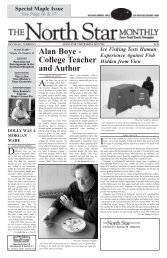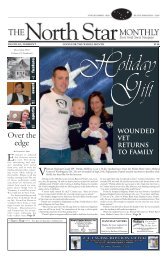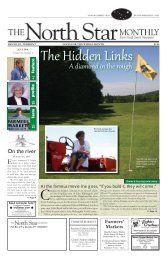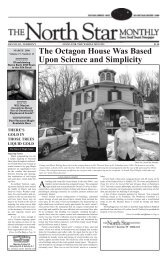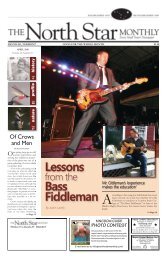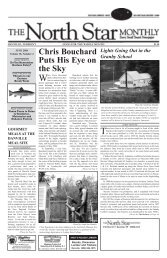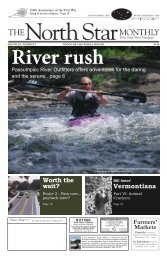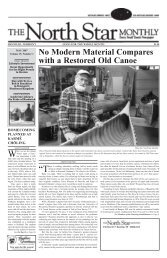www.northstarmonthly.com NOVEMBER 2009 23>> Page 1side us.<strong>The</strong>n she disappeared for awhile, and when we finally sawher again she was limping badly.She had a huge welt on her rightshoulder, and couldn’t put anyweight on that leg. Surely, she’dbeen hit by a car and we wonderedhow she could possiblysurvive. It was painful just towatch her, and <strong>the</strong> hunting seasonwould soon be underway.<strong>The</strong>re were hunters with treestands and blinds all around ourhouse, right by <strong>the</strong> apple trees,and more hunters would bepassing through. Indeed, we didn’tsee her at all until <strong>the</strong> seasonwas over. She must have waiteduntil night, joining <strong>the</strong> o<strong>the</strong>rs at<strong>the</strong> apples and leaving <strong>the</strong>ground clean by dawn. If youcan stand it, and protect <strong>the</strong>young trees, this natural gleaningby deer is a great way of keepingan orchard relatively disease free.Within a few days after <strong>the</strong>season ended she was back,cleaning up what was left of <strong>the</strong>garden now; <strong>the</strong> stalks of <strong>the</strong>Brussels sprouts and <strong>the</strong> broccolifirst and <strong>the</strong>n everythingelse. I use an “electro-net” sheepfence around <strong>the</strong> garden and <strong>the</strong>moment <strong>the</strong> fence comes down<strong>the</strong> deer go in. It gives <strong>the</strong>m anice boost as winter approaches,as do <strong>the</strong> tops of hardwoodswhich I fell at this time and leaveon <strong>the</strong> ground for a year beforebucking <strong>the</strong>m into firewood. Wehave an interesting relationship,me and <strong>the</strong> deer, a love-hate sortof thing which has finally mellowedinto a benign acceptance.Hunting is a part of it, and hasto be.But that year, like <strong>the</strong> yearsthat followed, <strong>the</strong> winter cameearly and hard. Deep snows keptgetting deeper, interspersed onlywith freezing rains which put acrust on <strong>the</strong> snow, a cruel crustwhich <strong>the</strong> deer broke throughbut <strong>the</strong> coyotes did not. <strong>The</strong>n<strong>the</strong> cold would return with bitingwind and more snow forweeks on end. One evening Iwatched as <strong>the</strong> deer emerged in aline from <strong>the</strong>ir wintering placeamongst <strong>the</strong> cedar and struggledtowards <strong>the</strong> orchard with <strong>the</strong>pale hope of finding an applewhich <strong>the</strong>y had not found before.It was like watching an olddocumentary film of <strong>the</strong> Siegeof Leningrad; six or eight deerin a row, struggling in <strong>the</strong> tracksof those ahead, bowed against<strong>the</strong> storm, one limping badly,and of course <strong>the</strong>re were no apples.By March, I could tell by <strong>the</strong>calls of <strong>the</strong> ravens that <strong>the</strong>rewere dead deer all about, pulleddown by <strong>the</strong> coyotes which hadhowled through <strong>the</strong> moonlitnights, or simply starved. In afew more weeks I found <strong>the</strong>irbones back in <strong>the</strong> swamp andbeyond and also saw that notonly had <strong>the</strong> deer eaten my azaleasand blueberries but <strong>the</strong>y haddecimated <strong>the</strong> woodland shrubssuch as moosewood too. Yet by<strong>the</strong> time things were really green,“Granny” was back, and with afawn again. She was still limpingbut she looked pretty good o<strong>the</strong>rwise,with a beautiful copperysummer coat. That fall I wassure she had been shot during<strong>the</strong> youth day, a young man tooka nice doe right where she usedto bed down, but it wasn’t herand even though <strong>the</strong> followingwinter was almost as bad as <strong>the</strong>one before she was back again in<strong>the</strong> spring.But now, as I watch, I can alreadysee her ribs through hergray winter coat. This is not agood sign, and her leg has gottenso bad she can hardly move.She inches forward, bends overpainfully to reach apples on <strong>the</strong>ground and cannot reach up forthose above her. This year’s fawnis grazing nearby. <strong>The</strong>n <strong>the</strong>fawn, full of youth and energyand delighted by <strong>the</strong> apples and<strong>the</strong> golden evening light, boundsto her side. She turns slowly tolick <strong>the</strong> fawn, and <strong>the</strong>ir tails flutterwith mutual affection. I amreminded of my own grandmo<strong>the</strong>rwho raised me and wasso crippled by arthritis herselfby that time in her life that she,too, could hardly hobble out to<strong>the</strong> apple trees, and for a momentI, and she, and <strong>the</strong> deer areall one.
24 NOVEMBER 2009 THE NORTH STAR MONTHLYGreen Cheese by Peter DannenbergSleeping UglyBY PETER DANNENBERGAs I nod off in front of<strong>the</strong> TV late at night, I’moften jolted awake by loud adsfor things to help me sleep. Inone, a rooster perches on <strong>the</strong>blankets and crows until <strong>the</strong>woman in bed with it pops apill. <strong>The</strong> bird <strong>the</strong>n sauntersoff to disturb ano<strong>the</strong>r lightsleeper. A fowl who mistakesmy bed for a henhouse willsoon be guest of honor at achicken pie supper. After asecond helping, I’ll sleepsoundly without pharmaceuticalnostrums.A woman in a different admight be jubilant because <strong>the</strong> roosterleft. She sets a glass of red wineon her mattress and jumps up anddown on <strong>the</strong> bed. Her bedmategrins foolishly at <strong>the</strong>se bizarre antics,probably because he suspectsshe’s taken leave of her senses andfears for his life. He waits for herto somersault away, so he can gulp<strong>the</strong> wine and flee down <strong>the</strong> roadafter <strong>the</strong> rooster. Apparently, Scandinaviansinvented <strong>the</strong> “miraclefoam” mattress because <strong>the</strong>y havean urgent need to practice gymnasticsin bed without spilling <strong>the</strong>irnightcaps. I haven’t glimpsed suchathleticism in my bedroom.Ano<strong>the</strong>r device is a home versionof a double hospital bed.With it, you can practice yogawithout actually using your musclesto contort yourself.Lindsay Wagner, who starredas <strong>the</strong> Bionic Woman in <strong>the</strong> lateseventies has one more solutionfor tossing and turning. She wantsme to work out my perfect firmnesssetting on <strong>the</strong> adjustable mattressshe sells. Lindsay warns me tofine-tune her mattress to preciselyFinding Time and Spacefor Yourself in VermontBrian S. Ward offers Holistic Coaching and MeditationInstruction in life transition as well as coachingand counseling for tobacco cessation, weightmanagement, bereavement and caregiving. Privateinsurance accepted, Medicaid accepted.(802) 684-3636 or www.consciousconsultingandcoaching.comWhen you think insurance...FRIDAY NIGHT SPECIALChicken Pie Buffet.................$9.95DanvilleRestaurant & InnCASUAL DINING & LODGINGFULLY LICENSEDSATURDAY NIGHTSmorgasboard......................$11.95Seatings are at 5:00 & 6:30 p.m. Dinner Reservations are suggested.BREAKFASTTuesday - Saturday 7 - 10:45 a.m.my ideal setting or suffer exhaustion<strong>the</strong> next day. <strong>The</strong> formula involvesmy height, weight, genderand sleep position. Lindsay probablyhad a computer implantedwhen TV scientists rebuilt her. Ihave nightmares about endlesslyfiddling with controls. What if Imiss my perfect setting by a pointor two, roll over into my wife’s territoryor put on pounds from toomuch chicken pie?I’d lose sleep over all <strong>the</strong> recalculations.For me, bedtime math islimited to counting sheep, but stillano<strong>the</strong>r mattress maker brags it’sthrowing counting sheep out ofwork. Where are animal rights activistswhen you need <strong>the</strong>m?At least <strong>the</strong> waterbed fad is defunct.Back <strong>the</strong>n, fear of floodsmurdered sleep. And that waswithout worrying whe<strong>the</strong>r <strong>the</strong> livingroom ceiling could support <strong>the</strong>weight of <strong>the</strong> pond in <strong>the</strong> bedroomabove. If <strong>the</strong> power failed inJanuary, you might resemble apolar bear napping on an ice floe.It’s not enough to fret over myown rest. My snoring might disturbmy wife. Luckily, TV has aglut of remedies to restore domestictranquility. <strong>The</strong>re are devicesto jam into my mouth andmove my jaw forward and adhesivestrips to flare my nostrils. <strong>The</strong>latter might have odoriferousdrawbacks if poultry strut about in<strong>the</strong> master bedroom. If I stopsnoring, how will I drown out <strong>the</strong>shouting TV pitchmen who rouseme from slumber?<strong>The</strong> best sleep aids I’ve foundare TV crime dramas that are morecriminal than dramatic. <strong>The</strong>se sopoorly written that it is obvious“whodunit” before <strong>the</strong> secondcommercial break. <strong>The</strong> cluelessfelons must be visitors from ano<strong>the</strong>rplanet. <strong>The</strong>y roam <strong>the</strong> universeseeking a good night’s sleep.I suspect <strong>the</strong>ir real motives formayhem are faulty computers thatmessed up sleep settings on <strong>the</strong>irspaceship’s couches. Yawning, <strong>the</strong>yhad almost drifted off, when a tooloudcommercial startled <strong>the</strong>minto pushing <strong>the</strong> wrong button and<strong>the</strong>y crash-landed in our midst.Miffed and cross, <strong>the</strong>y vowed towander <strong>the</strong> world and wreakvengeance on TV actors. If Lindsaywasn’t bionic, <strong>the</strong>y would havevaporized her.At times, even events on ourown planet are eerie. I onceLUNCHTuesday - Friday 11 a.m. - 1:00 p.m.Main Street, Danville VermontSteve A. Cobb, Owner & Justice of <strong>the</strong> Peace / Notary PublicWeddings / Civil Unions / By appointment or by chance802-684-3484worked for a health institute that,among hundreds of studies, researchedzombies in Haiti. It waslooking for folk remedies to exploitas new medicines. Scientistssuspected voodoo practitioners ofdrugging <strong>the</strong>ir victims to deprive<strong>the</strong>m of free will and make <strong>the</strong>mseem to be walking dead, or at leastsleepwalkers. That would be adandy cure for insomnia, for thosenot already turned into zombies bybad TV.TV ads for sleeplessness remediesshow actors snoozing with beatificsmiles. I never saw suchhappy dozers. Those slumberingin my Army barracks were sleepingugly, not sleeping beauty.Mouths gaped, drool trickleddown chins and snores reverberated.But maybe that was becausewe slept in tee shirts and boxershorts on thin mattresses. If we retiredlike TV hucksters, in silkendesigner sleepwear, on preciselypersonalized miracle foam, toppedwith satin sheets, in king-sizedbeds, with a goblet of mulled wine,we might have been more blissful.Until that rooster woke us.OPTICAL SHOP • EYE EXAMS & GENERAL EYE HEALTH • CONTACT LENS FITTINGS • SURGERY & LASER SURGERYwww.eyeassociatesnne.comEAST BURKE SPORTSfrom skis to snowshoes to bikes and boatsSPECIALski & snowboardTUNE-UPSends 12/5/09Get your Christmasshopping done atend-of-season pricing!layaway ‘til xmas663 Old Center Road,St. Johnsbury, Vermont 05819(802) 748-8797Fax (802) 748-8609$20$30 with binding adjustmentSEASON RENTALSadult ski pkg............$170jr ski pkg ..................$130jr snowboard pkg....$170buy it for $299!<strong>The</strong> doctor cansee you now.|Introducing Krista N. Haight, MDEye Associates is pleased to welcome <strong>the</strong>latest member of our vision-care team. KristaN. Haight, MD, is now accepting appointmentsin our St. Johnsbury and Littleton offices for• routine eye appointments and consultations• general ophthalmic problems• medical treatment of glaucoma• laser treatment of diabetic eye diseaseand glaucoma• cataract surgery with lens implantation(802) 626-3215Rt. 114, East Burke, VTHOURS:Tues - Sat 9:30 - 5:30Sun 10-5 • Closed MondaysST. JOHNSBURY, VERMONT MEDICAL ARTS BUILDING 1290 HOSPITAL DRIVE 802 748-8126LITTLETON, NEW HAMPSHIRE LITTLETON REGIONAL HOSPITAL 580 ST. JOHNSBURY ROAD 603 444-2484BRIAN MAWHINNEY, OD • PAUL LINDSTROM, OD • KRISTA HAIGHT, MD • STEPHEN PHIPPS, MD • TED V.J. HOULE, MD



